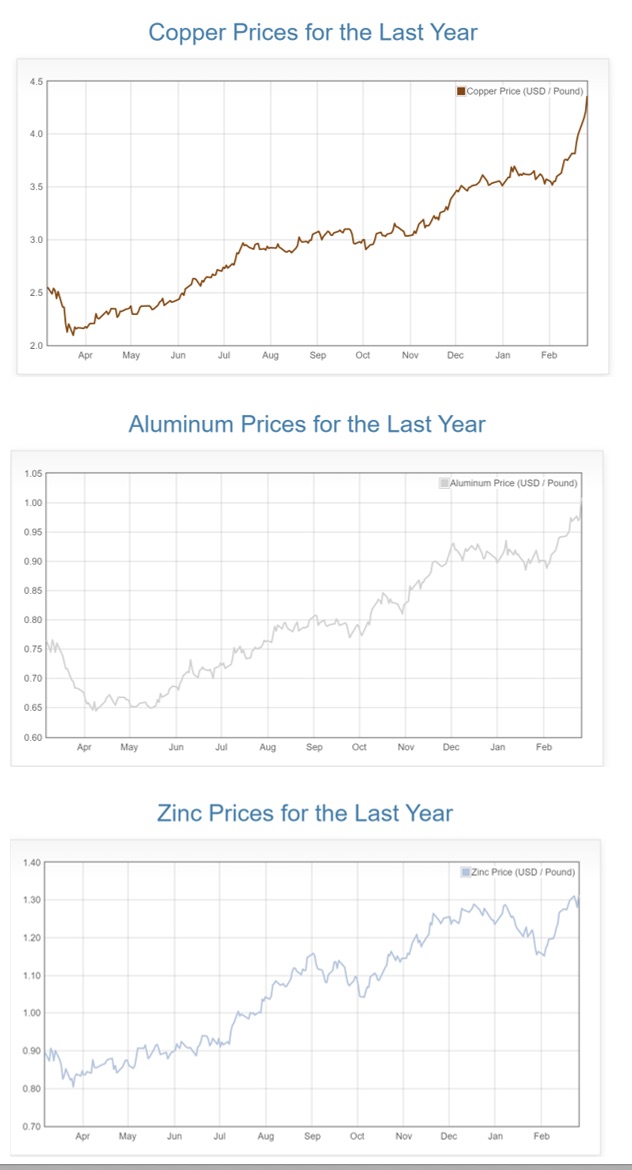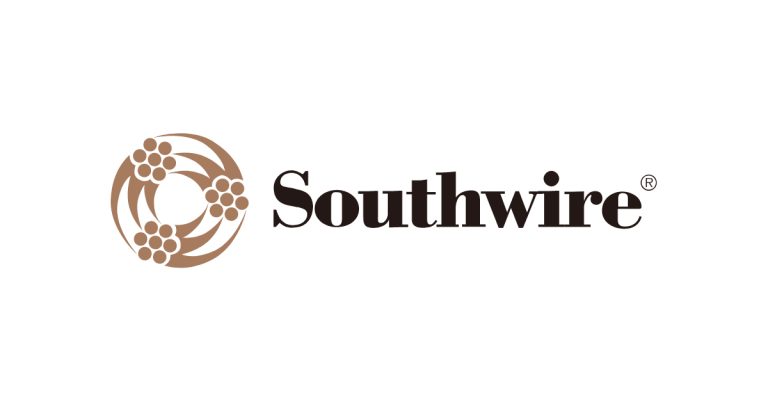Rising Metal Prices… the Why and Possible Consequences

Mar 1, 2021
By David Gordon
The year has started with seemingly every manufacturer raising prices due to meta pricing. There is a myriad of reasons ranging from a strong residential market to COVID-19 affecting mines and transportation; from production shortfalls to China’s consumption; from the rise in oil impacting transportation costs to COVID-19 impacting ships transiting from the Far East to offloading delays at ports in the U.S. Lots of reasons, but the end result is no different… rising prices.
These charts highlight the rise in pricing over the past year for copper, aluminum and zinc.

The charts above are courtesy of www.dailymetalprice.com/ and are 12-month charts from February 27, 2020 to February 28, 2021.
Other metals have also increased.
And the price of oil, and chemicals in general, affect the price of resin and, coupled with residential growth and natural disasters, the price of PVC has increased significantly.
A recent article entitled “Are Copper Prices Here to Stay?” highlighted some of the core reasons why copper has increased. Key points include:
• COVID-19 has affected employees at the mines and therefore restricted production
• China has recovered from COVID-19 faster than expected and hence their consumption has increased. And China is the world’s largest imported of copper. This is for construction and manufacturing in China.
• The growth of electric vehicles, worldwide, is affecting copper consumption as electric vehicles, and the broader renewables market, use more copper. It’s projected that copper capacity growth needs to increase by 4-5% annually to offset expected renewables demand for copper. The current capacity growth rate has only been 1% since 2017. So, “green” isn’t so green.
It’s estimated that global production contracted by 1% for the first 9 months of 2020 and that global refined output increased by 1.5%.
John Gross, John E Gross Consulting, Inc. noted copper economist, wrote about the challenge in opening new mines with highlighted two domestic copper mines that were planned that were shut down last year. He also highlighted a number of the products that utilize copper, inclusive of renewables.
In his article, Gross highlights that in 2020 there was a deficit in production of 390,000 mt on top of a 2019 deficit of 330,000 mt. So, consumption outpaced production by 720,000 mt over the past two years.
So, as he says, “It’s no wonder that prices have been rising.”
In 2021 it is projected that there will continue to be greater copper demand than supply, which means price probably won’t decline in the near future.
So, while the price will be the price, the bigger issue may perhaps be the law of unintended consequences. With wire and cable representing 15-20% of a distributors business and a much higher percentage of a distributor’s business being impacted by price increases (all of the lighting fixture companies have increases of 3-10% and wiring device companies are in the 2-4% range and box and fittings companies are … and cable tray manufacturers are … and PVC pipe manufacturers are … you get the point.
Some of these issues we wrote about almost exactly 10 years ago!
• The increase can easily provide a sense of false sales performance.
• Are sales really increasing? If you only track sales dollars, yes. But perhaps need to get back to tracking units and number of orders.
• Are you noticing a rise in sales compensation for outside salespeople and maybe inside salespeople? Is it due to them selling or increased sales prices and increased gross margin dollars … but no increase in market share or the number of units sold?
• Is inventory valuation increasing due to the rise in COGS?
• Are you informing your banking relations that inventory values may increase?
• Need to be cautious with outstanding quotes, and forthcoming ones. What did contractors quote a project at and what is copper (or the other materials) today? Could they end up outside down on a project? Would that affect their ability to pay?
And with all of these price increases there is always the opportunity to selectively enhance your gross margins. Not on A or maybe B items, but a little bit on C’s and D’s means profit dollars that can drop to your bottom line.
While there is a plethora of price increases coming through the pipeline and it is doubtful that manufacturers will stay to the traditional “one” a year as they are getting smarter about passing costs along quicker than ever, it is important to dedicate the resources to get these into your system quickly as every day missed is lost dollars. While digital systems are supposed to help … they don’t always do.
What goes up does at some point go down. As metals recede at some point, manufacturers may or may not, for finished goods / engineered products, reduce into-stock pricing and only be responsive on project opportunities. This is where purchasing analytics and good negotiators can earn their value.
While pricing goes up, make sure you don’t get caught in the law of unintended consequences.
David Gordon is President of Channel Marketing Group. Channel Marketing Group develops market share and growth strategies for manufacturers and distributors and develops market research. CMG’s specialty is the electrical industry. He also authors an electrical industry blog, www.electricaltrends.com. Channel Marketing Group does not engage with clients on detailed pricing strategies, however, given that pricing is a critical element of sales, marketing and growth planning, we do get asked about the topic and can share opinions and refer to those who focus on the area as well as share anecdotes. David Gordon can be reached at 919-488-8635 or dgordon@channelmkt.com.











